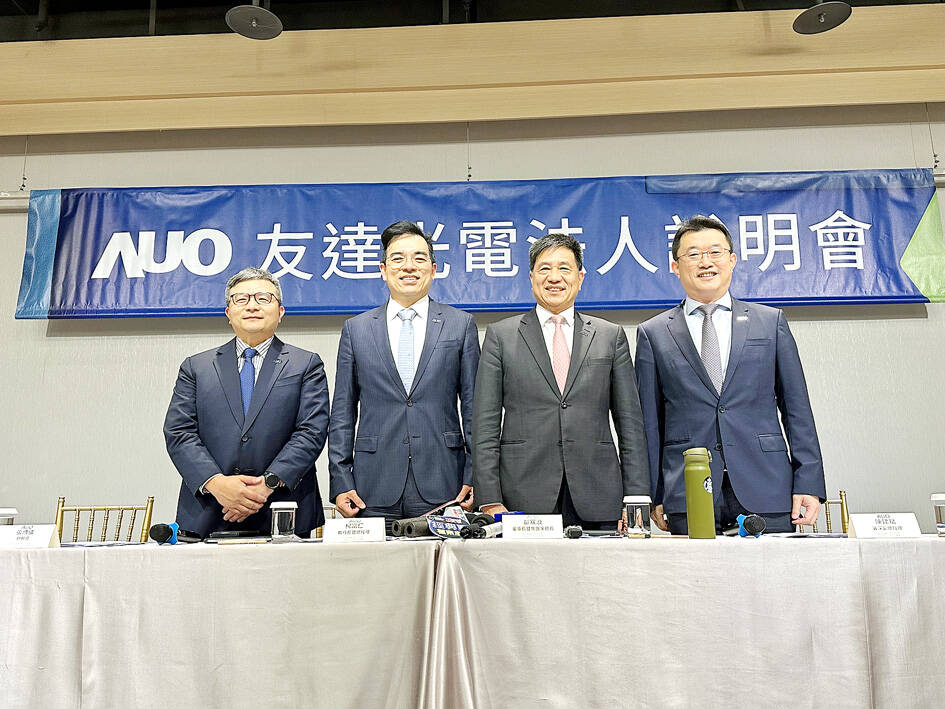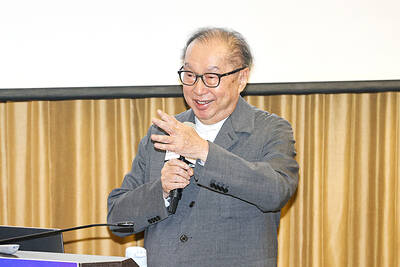Flat-panel maker AUO Corp (友達) aims to offer shareholders a cash dividend of NT$0.3 per common share this year even though it incurred losses of NT$3.06 billion (US$93.29 million) last year, the company said in a regulatory filing yesterday.
The company’s board of directors has approved a plan to use its legal reserve and capital surplus of about NT$2.3 billion for the payout, AUO said.
The company’s net loss last year was a marked improvement from losses of NT$18.2 billion the previous year, thanks to a turnaround last quarter due to non-operating gains from the sale of factory assets.

Photo: Chen Mei-ying, Taipei Times
AUO reported revenue of NT$68.69 billion last quarter, up 8.4 percent from the fourth quarter of 2023. Net profit was NT$1.62 billion compared with a net loss of NT$1.51 billion a year earlier. The company posted earnings per share of NT$0.21 for last quarter.
For the whole of last year, revenue increased 13 percent annually to NT$280.25 billion, while losses per share improved to NT$0.4 from NT$2.37 a year earlier, the company’s financial statement showed.
AUO booked divestment gains of NT$4.72 billion last year by selling two plants at the Southern Taiwan Science Park (南部科學園區) in Tainan, as well as plants and land at the Central Taiwan Science Park (中部科學園區) in Taichung’s Houli District (后里) to Micron Technology Inc.
The board yesterday approved a plan to sell some buildings at solar energy subsidiary AUO Crystal Corp’s (友達晶材) Houli plant, as well as facilities and moveable assets to Micron for NT$3.05 billion.
The company expects a divestment gain of NT$1.8 billion from the latest deal, it said.
AUO chairman Paul Peng (彭双浪) told an earnings conference yesterday that the subsidiary would cease its solar monocrystalline wafer production this year and focus on semiconductor wafer testing.
Last year, total solar installations in Taiwan decreased by 40 percent from the previous year, leading AUO's solar business to see revenue decline by 60 percent, Peng said.
Regarding AUO’s core flat-panel display business — which accounted for about 55 percent of its total revenue last year — Peng said overall demand this quarter looks good, especially for TV panels above 85 inches, citing positive factors such as China’s efforts to boost domestic consumption and disciplined production by peers.
While flat-panel display revenue this quarter is expected to be slightly lower than the previous quarter, as the Lunar New Year holiday cut short the number of business days, it would grow in the following quarters, he said.
AUO holds a mixed outlook for the company’s non-display business, or the total solutions for vertical and mobility industries, this quarter.
The vertical solution business covers integrated solutions in various fields, such as smart retail, smart healthcare, and other industrial and public displays, while the mobility solution business mainly focuses on integrated services in the automotive sector, according to the company.
Revenue from the vertical solutions business — which contributed 14 percent of revenue — is expected to show a low to mid-teens percentage increase this quarter from the previous quarter, but revenue from the mobility solutions business — accounting for 25 percent of total sales — would decline by a high-single-digit percentage, the company said.
AUO chief financial officer David Chang (張博儀) said yesterday capital expenditure this year would not exceed NT$30 billion as the company adopts an asset-light strategy. The company allocated about NT$26.9 billion to capital expenditure last year.
Meanwhile, the board yesterday also approved a share buyback plan as it aims to solidify its credit profile and safeguard shareholders’ interests, the company said in a separate filing to the Taiwan Stock Exchange.
AUO proposed to buy back 153.36 million shares, or 2 percent of the company’s outstanding shares, at NT$9.56 to NT$21.26 per share in the next two months beginning today, it said.

BYPASSING CHINA TARIFFS: In the first five months of this year, Foxconn sent US$4.4bn of iPhones to the US from India, compared with US$3.7bn in the whole of last year Nearly all the iPhones exported by Foxconn Technology Group (富士康科技集團) from India went to the US between March and last month, customs data showed, far above last year’s average of 50 percent and a clear sign of Apple Inc’s efforts to bypass high US tariffs imposed on China. The numbers, being reported by Reuters for the first time, show that Apple has realigned its India exports to almost exclusively serve the US market, when previously the devices were more widely distributed to nations including the Netherlands and the Czech Republic. During March to last month, Foxconn, known as Hon Hai Precision Industry

Taiwan Semiconductor Manufacturing Co (TSMC, 台積電) and the University of Tokyo (UTokyo) yesterday announced the launch of the TSMC-UTokyo Lab to promote advanced semiconductor research, education and talent development. The lab is TSMC’s first laboratory collaboration with a university outside Taiwan, the company said in a statement. The lab would leverage “the extensive knowledge, experience, and creativity” of both institutions, the company said. It is located in the Asano Section of UTokyo’s Hongo, Tokyo, campus and would be managed by UTokyo faculty, guided by directors from UTokyo and TSMC, the company said. TSMC began working with UTokyo in 2019, resulting in 21 research projects,

Ashton Hall’s morning routine involves dunking his head in iced Saratoga Spring Water. For the company that sells the bottled water — Hall’s brand of choice for drinking, brushing his teeth and submerging himself — that is fantastic news. “We’re so thankful to this incredible fitness influencer called Ashton Hall,” Saratoga owner Primo Brands Corp’s CEO Robbert Rietbroek said on an earnings call after Hall’s morning routine video went viral. “He really helped put our brand on the map.” Primo Brands, which was not affiliated with Hall when he made his video, is among the increasing number of companies benefiting from influencer

Quanta Computer Inc (廣達) chairman Barry Lam (林百里) yesterday expressed a downbeat view about the prospects of humanoid robots, given high manufacturing costs and a lack of target customers. Despite rising demand and high expectations for humanoid robots, high research-and-development costs and uncertain profitability remain major concerns, Lam told reporters following the company’s annual shareholders’ meeting in Taoyuan. “Since it seems a bit unworthy to use such high-cost robots to do household chores, I believe robots designed for specific purposes would be more valuable and present a better business opportunity,” Lam said Instead of investing in humanoid robots, Quanta has opted to invest